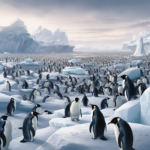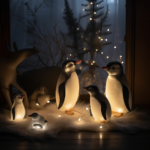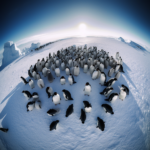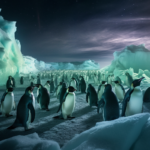Penguins are fascinating creatures that have captured the hearts of people all around the world. With their unique appearance and charming waddle, it’s no wonder they are so beloved. But have you ever wondered about the life cycle of these incredible birds? From birth to adulthood, penguins go through several stages of development, each with its own set of challenges and milestones. In this article, we will explore the different phases of a penguin’s life cycle, from egg to chick to adult, and discover the remarkable adaptations that help them survive in their icy habitats. So, let’s dive in and learn more about the incredible journey of penguins!
Key Takeaways
- Penguins have a unique life cycle that involves mating, egg-laying, incubation, and raising chicks.
- Penguins typically mate for life and return to the same breeding grounds each year.
- After mating, female penguins lay one or two eggs, which are then incubated by both parents.
- The incubation period can last from a few weeks to a couple of months, depending on the species.
- Once the chicks hatch, they are cared for and fed by both parents until they are old enough to fend for themselves.
- Penguins go through a molting process where they shed and replace their feathers, which helps them maintain their waterproofing and insulation.
- The life cycle of a penguin is closely tied to the availability of food, as they rely on the ocean for their main source of sustenance.
The Life Span of Penguins
Penguins are fascinating creatures that have captured the hearts of many people around the world. From their unique appearance to their remarkable adaptations, there is much to learn about these flightless birds. One aspect of their lives that often piques curiosity is their life span. How long do penguins live? Let’s explore the life span of penguins and the factors that influence it.
Penguin Life Expectancy
Penguins have varying life expectancies depending on the species and their environment. On average, most penguin species have a life span of around 15 to 20 years in the wild. However, some species, such as the Emperor Penguin, have been known to live up to 20 to 30 years or even longer. In captivity, where they are protected from predators and have access to a consistent food supply, penguins can live even longer, with some individuals reaching 30 to 40 years of age.
Factors Affecting Penguin Lifespan
Several factors influence the life span of penguins. These include:
-
Species: Different penguin species have different life expectancies. Larger species tend to have longer life spans compared to smaller ones.
-
Environment: Penguins that inhabit colder regions, such as the Antarctic, tend to have longer life spans compared to those in milder climates. The harsh conditions in polar regions provide protection from predators and reduce the risk of disease.
-
Predators: Predation is a significant threat to penguins, especially during their vulnerable stages, such as when they are nesting or molting. Predators like seals, sea lions, and sharks can significantly impact penguin populations and reduce their life expectancy.
-
Food Availability: Penguins rely on a steady supply of food to survive and reproduce. Changes in ocean currents, overfishing, and climate change can disrupt their food sources, leading to malnutrition and reduced life spans.
-
Human Impact: Human activities, such as pollution, habitat destruction, and climate change, pose significant threats to penguins. Oil spills, for example, can coat their feathers, impairing their ability to swim and stay warm. These human-induced factors can negatively impact penguin populations and reduce their life expectancy.
Longevity in Captivity
Penguins kept in captivity often have longer life spans compared to their wild counterparts. This is primarily due to the absence of natural predators, consistent food supply, and access to veterinary care. Zoos and aquariums provide a controlled environment where penguins can thrive and live longer lives. For example, the oldest known penguin in captivity, a Gentoo Penguin named Olde, lived to be 41 years old at the Odense Zoo in Denmark.
Conclusion
Understanding the life span of penguins is crucial for conservation efforts and ensuring their long-term survival. By studying the factors that influence their life expectancy, researchers can better protect these incredible birds and their habitats. Whether in the wild or in captivity, penguins continue to captivate us with their unique behaviors and adaptations, reminding us of the importance of preserving their fragile ecosystems.
The Stages of a Penguin’s Life Cycle
A. Egg Stage
The life cycle of a penguin begins with the egg stage. Penguins are unique birds because they lay eggs, just like reptiles. The female penguin lays one or two eggs, depending on the species, and then carefully transfers them to the male penguin to incubate. This is known as shared incubation, where both parents take turns keeping the eggs warm.
During the egg stage, the penguin parents work together to protect the eggs from predators and harsh weather conditions. They create a nest made of stones or pebbles to keep the eggs off the cold ground. The eggs are also covered with a layer of feathers to provide insulation.
The incubation period for penguin eggs varies depending on the species, but it usually lasts between 30 to 60 days. During this time, the parents take turns incubating the eggs, ensuring they are kept at the right temperature. The eggs are carefully rotated to prevent the embryos from sticking to the shell.
B. Chick Stage
Once the eggs hatch, the penguin enters the chick stage. Penguin chicks are covered in soft down feathers and are completely dependent on their parents for food and protection. The parents take turns feeding the chicks a diet consisting of regurgitated fish and krill.
During the chick stage, the parents continue to provide warmth and protection. They form crèches, which are groups of chicks that huddle together for warmth and safety. This also helps protect them from predators, such as skuas and sea lions.
As the chicks grow, they develop waterproof feathers, which allow them to swim and dive for food. They also start to molt their down feathers, replacing them with adult feathers. This process can take several weeks.
C. Juvenile Stage
After the chick stage, penguins enter the juvenile stage. At this point, they have grown significantly and are able to swim and catch their own food. However, they still rely on their parents for guidance and protection.
During the juvenile stage, penguins learn important survival skills, such as hunting and navigating the ocean. They also start to explore their surroundings and interact with other young penguins. This stage is crucial for their development and prepares them for adulthood.
D. Adult Stage
The final stage of a penguin’s life cycle is the adult stage. Once penguins reach adulthood, they are fully independent and capable of reproducing. They have developed the necessary skills to survive in their habitat and face the challenges of the wild.
Adult penguins form breeding colonies during the mating season, where they find a mate and establish a nesting site. They engage in courtship rituals, such as calling and displaying their feathers, to attract a partner. Once a pair bonds, they mate and lay eggs, starting the life cycle anew.
In conclusion, the life cycle of a penguin consists of four stages: the egg stage, chick stage, juvenile stage, and adult stage. Each stage is essential for the penguin’s growth and survival. From the moment they hatch from their eggs to the time they become independent adults, penguins go through a remarkable journey that showcases their resilience and adaptability in their unique polar habitats.
The Habitats of Penguins
Penguins are fascinating creatures that have adapted to survive in some of the harshest environments on Earth. They are found primarily in the Southern Hemisphere, with the majority of species residing in Antarctica. However, penguins can also be found in other regions such as South Africa, New Zealand, and South America. Let’s explore the different habitats where penguins thrive.
Antarctic Region
When we think of penguins, we often envision them waddling across the icy landscapes of Antarctica. This polar region is home to several penguin species, including the Emperor Penguin, Adélie Penguin, and Chinstrap Penguin. These penguins have evolved to withstand extreme cold temperatures, with their thick layers of blubber and dense feathers providing insulation against the frigid environment.
In Antarctica, penguins inhabit the coastal areas where they can access the ocean for food. They build their nests on rocky shores or in snow burrows to protect their eggs and chicks from the harsh elements. The icy waters surrounding Antarctica are rich in marine life, providing an abundant food source for these remarkable birds.
Subantarctic Islands
Beyond Antarctica, penguins can also be found on various subantarctic islands. These islands, located in the Southern Ocean, provide a more temperate climate compared to the icy continent. Here, penguins such as the King Penguin, Gentoo Penguin, and Macaroni Penguin thrive in milder conditions.
The subantarctic islands offer a diverse range of habitats for penguins. They feature rocky coastlines, grassy slopes, and pebble beaches where these birds can establish their colonies. The surrounding waters are teeming with fish, squid, and krill, which form the mainstay of the penguins’ diet.
South Africa and South America
Moving away from the polar regions, penguins have also found suitable habitats in South Africa and South America. In South Africa, the African Penguin, also known as the Jackass Penguin, can be found along the country’s coastline. These penguins nest in burrows or rocky crevices, seeking protection from predators and the scorching African sun.
In South America, the Humboldt Penguin and Magellanic Penguin are the most common species. They inhabit the coasts of Chile, Peru, and Argentina, where they breed and raise their young. These penguins have adapted to the warmer climates of these regions, with their sleek feathers and efficient cooling mechanisms.
New Zealand and Australia
Lastly, penguins have also established habitats in the southern regions of New Zealand and Australia. The Yellow-eyed Penguin, Fiordland Penguin, and Little Penguin (also known as the Fairy Penguin) are native to these areas. They prefer forested coastal areas, nesting in burrows or under vegetation.
New Zealand and Australia offer a mix of temperate and subtropical climates, which provide a unique environment for penguins. These birds have adapted to the diverse landscapes, including sandy beaches, rocky shores, and dense forests. They rely on the surrounding oceans for their food supply, feasting on small fish, squid, and crustaceans.
In conclusion, penguins have adapted to a wide range of habitats across the Southern Hemisphere. From the icy landscapes of Antarctica to the subantarctic islands, and even the coasts of South Africa, South America, New Zealand, and Australia, these remarkable birds have found ways to thrive in various environments. Their ability to adapt and survive in these habitats is a testament to their resilience and the wonders of nature.
Unique Behaviours of Penguins
A. Why Do Penguins Just Stand Around?
Penguins are known for their distinctive behavior of standing around in groups, often referred to as “penguin huddles.” While it may seem like they are simply idle, there are actually several reasons why penguins engage in this behavior.
-
Thermoregulation: Penguins inhabit some of the coldest regions on Earth, such as Antarctica and the sub-Antarctic islands. By standing close together in a huddle, penguins can conserve body heat and shield themselves from the harsh elements. The tightly packed group helps to minimize heat loss and keep each individual warm.
-
Protection from predators: Standing in a huddle also provides protection against predators. Penguins are vulnerable to attacks from predators such as seals and sea lions. By standing together, they create a larger, more intimidating presence, making it less likely for predators to approach and attack.
-
Energy conservation: Penguins have a unique adaptation that allows them to conserve energy. By standing still, they reduce the amount of energy expended, which is crucial in their cold and harsh environment where food can be scarce. This behavior helps them to conserve energy for activities such as hunting and breeding.
B. Other Notable Penguin Behaviours
Apart from their huddling behavior, penguins exhibit various other interesting behaviors that contribute to their survival and social dynamics. Here are some notable penguin behaviors:
-
Courtship rituals: Penguins engage in elaborate courtship rituals to attract a mate. These rituals often involve displays of vocalizations, head movements, and flapping of wings. Each penguin species has its own unique courtship behaviors, which play a vital role in pair bonding.
-
Nest building: Penguins are known for their meticulous nest-building skills. They use rocks, pebbles, and other materials to construct nests, which provide protection and insulation for their eggs and chicks. Some penguins even use their own feces to build their nests, as the dark color helps to absorb heat from the sun.
-
Feeding strategies: Penguins are skilled hunters and employ various feeding strategies depending on their species and the availability of prey. Some penguins dive deep into the ocean to catch fish and squid, while others feed closer to the surface. They can swim at high speeds and use their wings as flippers to maneuver underwater.
-
Parenting duties: Penguins are dedicated parents and share the responsibilities of incubating eggs and raising chicks. After laying their eggs, the female penguin transfers the egg to the male, who then incubates it on his feet, keeping it warm and protected. Once the chicks hatch, both parents take turns feeding and caring for them until they are old enough to fend for themselves.
-
Molting: Penguins undergo an annual molt, where they shed and replace their old feathers. During this time, they are unable to swim and hunt, so they gather in large groups on land or ice to conserve energy and protect themselves from predators. The molt is essential for maintaining their waterproof plumage, which is crucial for their survival in the water.
Penguins are fascinating creatures with unique behaviors that have evolved to help them thrive in their challenging environments. From huddling for warmth to engaging in complex courtship rituals, these behaviors are essential for their survival and contribute to the overall wonder of the penguin life cycle.
Interesting Facts About Penguin Life Cycle
Penguins are fascinating creatures that have captured the hearts of many. Their unique life cycle is filled with interesting facts that shed light on their remarkable adaptations and behaviors. Let’s dive into the world of penguins and explore their captivating life cycle.
1. The Breeding Season: A Time of Courtship and Nest Building
Penguins have a well-defined breeding season, which varies depending on the species and their geographic location. During this time, male penguins engage in elaborate courtship rituals to attract a mate. These rituals often involve displays of affection, such as bowing, calling, and offering pebbles as gifts.
Once a pair has formed, they work together to build a nest. Penguins are known for their meticulous nest-building skills, using rocks and pebbles to create a cozy and secure environment for their eggs. The nests are usually located on land, although some species, like the Emperor penguins, build their nests on ice.
2. The Egg: A Precious Incubator
After the nest is built, the female penguin lays a single egg and carefully transfers it to the male, who takes on the responsibility of incubation. This unique role reversal allows the female to replenish her energy reserves by going out to sea to feed.
During the incubation period, which can last anywhere from a few weeks to a couple of months, the male penguin diligently keeps the egg warm by balancing it on his feet and covering it with a special brood pouch. This pouch is a thick layer of skin that helps regulate the temperature and protect the egg from the harsh Antarctic elements.
3. Hatching: The Arrival of the Adorable Chicks
Once the incubation period is over, the egg hatches, and a fluffy chick emerges. Penguin chicks are incredibly adorable with their soft down feathers and big, curious eyes. They rely on their parents for warmth, protection, and food.
The newly hatched chicks are fed regurgitated food by both parents. Penguins have a unique feeding method where they store partially digested fish in their stomachs. They bring this food back to the nest and feed it to their chicks, ensuring they receive the necessary nutrients for growth and development.
4. Growth and Development: From Fluff to Feathers
As the chicks grow, they undergo various stages of development. Initially, they rely on their parents for warmth and protection, huddling together in groups called creches to stay safe from predators and the cold.
Over time, the chicks start to develop their waterproof feathers, which replace the down feathers. This process, known as molting, is crucial for their survival in the water. Once their feathers are fully grown, the chicks are ready to take their first plunge into the ocean and begin their independent lives.
5. Fledging and Independence: Taking Flight
After several months of parental care and growth, the young penguins reach a stage called fledging. During this time, they start to explore their surroundings, honing their swimming and diving skills. They gradually become more independent, venturing out to sea to hunt for food on their own.
Once they have mastered the art of swimming and fishing, the young penguins leave their birth colony and embark on their first migration. They join other penguins of their species and travel vast distances in search of food and suitable breeding grounds.
6. The Circle of Life: Reproduction and Continuation
As adult penguins reach sexual maturity, they return to their birth colonies to find a mate and start the cycle anew. They engage in elaborate courtship displays, reaffirming their bond and ensuring successful reproduction.
The life cycle of a penguin is a testament to their remarkable adaptations and resilience. From the courtship rituals and nest building to the hatching of adorable chicks and their subsequent growth and independence, penguins navigate the challenges of their environment with grace and determination.
By understanding the intricacies of the penguin life cycle, we can appreciate the incredible journey these birds undertake and the importance of preserving their habitats for future generations to marvel at their beauty and resilience.
Conclusion
In conclusion, the life cycle of penguins is a fascinating and unique process. From their courtship rituals and mating behaviors to the incubation and hatching of their eggs, penguins go through several stages in their life. They face various challenges, such as finding suitable nesting sites, protecting their eggs from predators, and ensuring the survival of their chicks. As the chicks grow, they undergo a period of rapid development and eventually fledge, becoming independent and joining their fellow penguins in the ocean. The life cycle of penguins is intricately connected to their environment, and their ability to adapt and thrive in harsh conditions is truly remarkable. By understanding the different stages of a penguin’s life, we can gain a deeper appreciation for these incredible creatures and the challenges they face in their quest for survival.
Frequently Asked Questions
Q1: What are the stages of a penguin life cycle?
The penguin life cycle typically includes the following stages: egg, chick, juvenile, and adult. The penguin egg is incubated by both parents for about 1-2 months. Once hatched, the chick is cared for and fed by its parents. As a juvenile, the penguin begins to gain independence but still retains its juvenile plumage. Upon reaching maturity, the penguin is ready to mate and reproduce, thus continuing the cycle.
Q2: How long do penguins live?
The lifespan of a penguin varies depending on the species. On average, most penguins live between 15-20 years in the wild. However, in captivity, where threats are minimized, they can live up to 25-30 years.
Q3: Where do penguins live?
Penguins are primarily found in the Southern Hemisphere, particularly in Antarctica. However, some species can be found in the temperate zones such as the Galapagos penguin which lives near the equator.
Q4: What are some facts about the penguin life cycle?
Penguins have a fascinating life cycle that includes stages of egg, chick, juvenile, and adult. They mate for life and both parents take turns incubating the egg. Once the chick hatches, it’s fed regurgitated food by its parents until it’s ready to hunt for itself.
Q5: Why do penguins just stand around?
Penguins often stand around in groups for warmth and protection against predators. This behavior is known as “huddling.” It’s especially common in extremely cold environments where they need to conserve body heat.
Q6: What is the penguin’s life expectancy?
The life expectancy of a penguin varies by species. For example, Emperor Penguins can live up to 20 years in the wild, while smaller species like the Little Blue Penguins have a life expectancy of about 6-7 years.
Q7: What is the penguin’s mating process?
Penguin mating processes vary by species, but most involve courtship displays to attract a mate. Once a pair is formed, they mate and the female lays one or two eggs. Both parents take turns incubating the eggs and caring for the chicks once they hatch.
Q8: What is the penguin’s diet?
Penguins primarily eat krill, fish, and squid. They are excellent swimmers and spend a significant amount of time hunting for food in the ocean.
Q9: What are the main threats to penguins?
The main threats to penguins include climate change, overfishing, pollution, and habitat destruction. Predators such as seals, sharks, and sea birds also pose a threat to penguins, particularly to eggs and chicks.
Q10: What efforts are being made for penguin conservation?
Numerous organizations are working towards penguin conservation. Efforts include protecting their habitats, implementing sustainable fishing practices, reducing pollution, and conducting research to better understand their needs and threats. Some species of penguins are also part of captive breeding programs to help increase their population.




